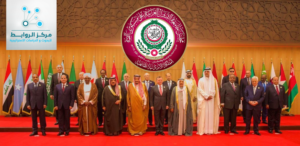 D.slam Mohammed Zaanoun *
D.slam Mohammed Zaanoun *
The Arab summit, which was held at the Dead Sea area of the Hashemite Kingdom of Jordan on 29 last March witnessed new variables that were not available at the previous summit held in Mauritania last year, they are:
The presence of 18 leaders out of 21 ones. In the forefront, including but not limited, the Saudi King Salman bin Abdulaziz , Egyptian President Abdel Fattah al-Sisi, and Amir Sheikh Sabah Al-Ahmad Al-Sabah, the Emir of Qatar Tamim Bin Hamad Al Thani, UAE Prime Minister and Ruler of Dubai, Mohammed bin Rashid Al Maktoum .
The presence of “Jason Greenblatt” personal adviser to US President “Donald Trump” and conduct bilateral meetings on the sidelines of the summit with the region’s leaders and their advisers. it has obvious implications on the topics discussed by the summit, namely, (the Arab-Israeli conflict, and the Iranian threat).
This comes to be consistent with the vision of the new US administration to restructure the Middle East, based on the renewal of ties with Arab allies, support its stability, with a willingness to use military force against Iran.
The face of the Iranian threat.
There seems to be an American effort to restore the Arab line-up in the face of Iranian expansion that seemed clear in three axes:
First: Reconciliation between Egyptian President Abdel Fattah al-Sisi and Saudi King Salman bin Abdulaziz, and it is clear that this reconciliation was discussed during the visit of Mohammed bin Salman to Washington in last March.
Second: The confirmation of Egyptian President Abdel Fattah al-Sisi in his speech on the need to face strongly to the extension of Iran in the Middle East.
Third: the King of the Hashemite Kingdom of Jordan Abdullah II has made efforts to persuade Arab leaders to create an Arab alliance to meet the challenges and threats to the Arab nation.
And the summit’s final statement marks on what is the new alliance in the face of Iran that it has called for the cessation of external interference in internal Arab affairs, and denounced Tehran’s attempts to ignite sedition between the Shiites and Sunnis, and the coming period will see active diplomatic movement between the Arab countries to discuss the formation of the new alliance against Iran, as well as the movement of active diplomacy with the United States of America, and the allies in the West.
The Palestinian-Israeli conflict
The final statement of the summit did not come with something new; where it stressed on the principle of “two-state solution,” ensures the establishment of an independent Palestinian state on the borders of 1967, with its capital in East Jerusalem, with the adoption of the Arab peace initiative, and to invite the world not to transfer their embassies to occupied Jerusalem, and the implementation of Security Council resolution 2334 against the Israeli settlements in the West Bank.
This marks that the summit sought to influence the discussions that take place within the US administration on the development of a proposal for a peaceful settlement between Israel and the Palestinians.
It is clear that there is a restructuring of the policies and alliances in the Middle East, and that the new US administration is seeking to impose a new order in the Middle East, but the challenge can be faced lies in the ability to convince leaders of new orientations especially with regard to the peaceful settlement between the Palestinians and Israelis.
Rawabet Center for Research and Strategic Studies
